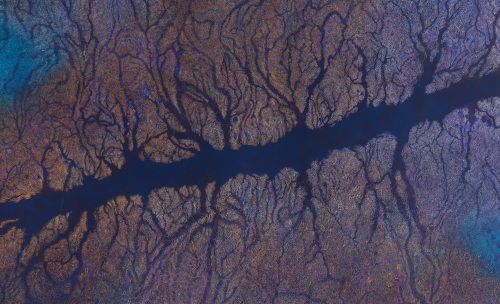
Love (detail), 2016, colored pencil, fingerprints, acrylic on canvas, 108 x 202 inches (274 x 513 cm)
Luisa Rabbia: COLLEZIONE MARAMOTTI
By Ida Panicelli
January 1, 2018
The color blue has been important to Luisa Rabbia’s artistic investigations since the 1990s. This show of ten works made between 2009 and 2017 adds new nuances and tonalities: violet, maroon, red. Drawing in pencil on acrylic
paint on paper or canvas, she weaves an intricate web of signs and achieves pictorial plenitude in the combination/opposition of a flat, frequently blue background and the vertiginous stratification of pencil marks. In these works, inner and outer landscapes coexist, demanding a variable perspective from viewers. At close range, one can perceive traces of the artist’s hand, in spirals of entangled colors and imprints of the artist’s fingertips, yet at the same time these works leave no doubt that Rabbia’s vision is expansive, conceiving and controlling vast spaces.
Love, 2016, from which the show takes its title, is the first painting in a trilogy that also includes Birth and Death, both 2017; all are the same size, nine feet by sixteen feet ten inches. (The latter two works will be exhibited for the first time at the Peter Blum Gallery in New York in February 2018.) In Love, two gigantic genderless figures are joined at their centers and hold hands, floating weightlessly over a blue space that might be an ocean, a cosmos, or an amniotic environment. The intimate landscape formed by the tantric union of two bodies extends into the outer one, consolidated through a vein- or rootlike structure that seems to fuse organic, human, and celestial geographies. Likewise, in NorthEastSouthWest, 2014, microcosm and macrocosm interweave in a nebulous primordial state. Four juxtaposed panels compose an image of a vital organ, perhaps a brain or a kind of heart; expanding from the center, the structure reaches toward infinity with tubular tentacles that continue beyond the frame in the four cardinal directions.
The vast and spectacular site-specific blue wall painting Another Country, 2017, is inspired by James Baldwin’s book of the same title. Baldwin’s phrase conjures the possibility of a place beyond race and gender. On the mural’s upper portion, an indistinct human multitude moves from right to left against a white background, with myriad blue heads created from the artist’s fingerprints. Present in Rabbia’s work since 2012, the fingerprint functions as a mark of individuality and alludes to the trace that every human being leaves over the course of a lifetime, regardless of gender or race. In the lower portion of the mural, deep roots drawn in white pastel stretch down into the tangled depths of history, from which we all have emerged. There is a longing for freedom in these human masses in motion, and if the roots seem to stifle free movement, they also provide nourishment, generation after generation.
Similarly, in I Want to Be There, Too, 2015, a thronging crowd formed by fingerprints in blue acrylic gathers on the banks of an impetuous, apocalyptic red river, apparently seeking to traverse it. One inevitably thinks of refugees crossing the Mediterranean. Moving once again from personal and inner experiences to the collective and social, Rabbia’s associations in this dramatic painting speak of empathy and the possibility of dialogue and encounter. Despite the demarcation line, the river’s currents allow the circulation of shared feelings, expectations, and fears— and assimilate individuals and crowds into the grand stream of history.
—Ida Panicelli
Translated from Italian by Marguerite Shore.